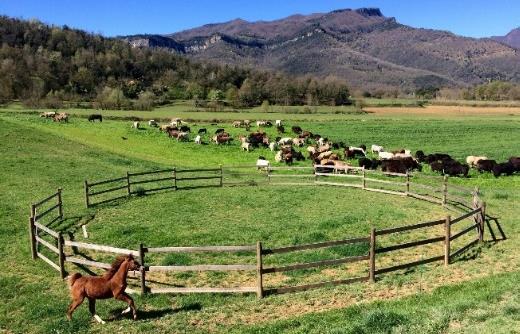Sustainable Livestock Farming
Spain
This demonstrator has as facility the farm Carrera D’en Bas, a cattle breeder and fattener farm. During the first 6-9 months calves are breastfed and they graze until they are separated from their mother to be fattened while the mother prepares itself to give birth to a new calf. In sustainable livestock farming such as Carrera den Bas, grazing is the easiest way to reduce costs. The daily livestock operation is based on the management of the animals that are grazing, since the herds with large extensions of pastures, in which there are shrubs and trees, it is difficult to find the cows and calves. It is necessary to know the location of the cows, those that close to the calving date, those that in-heat, the position of their calf, the health of cows and calves. However once the grazing season is finished, and for those animals being fattened, agriculture must provide 100% of the feed to livestock. The staple crops are prairie grass, oats, ryegrass, corn. At the moment the farmer does not have enough time to attend the agricultural and livestock tasks, and can not afford to hire more personnel. Crops need to know when to water, defend against possible pests, presence of weeds, macro and micronutrient levels, the best time to harvest, etc. Now they are unknown to farmers who are not equipped with sensors and information systems and decision support.

Precision agriculture, through the sensorization of animals and crops is the only way to increase the productivity of livestock farms and meet the requirements that will demand the market. Digital transformation will have a huge impact on the agrifood sector. This approach needs the environmental conditions parameters and a weather forecast from external services. In fact, the aim is to estimate not only fertilization, but also the optimal timing for cutting the plants as a preparation for the final harvest taking into account the environmental and the soil conditions.
The expected results from this holistic scenario are IoT wearables for livestock, drones and sensors- based solution with autonomous management of data are a good solution to have a fast, cost- efficient and exact analysis methods for an optimal management of cropping and livestock.
